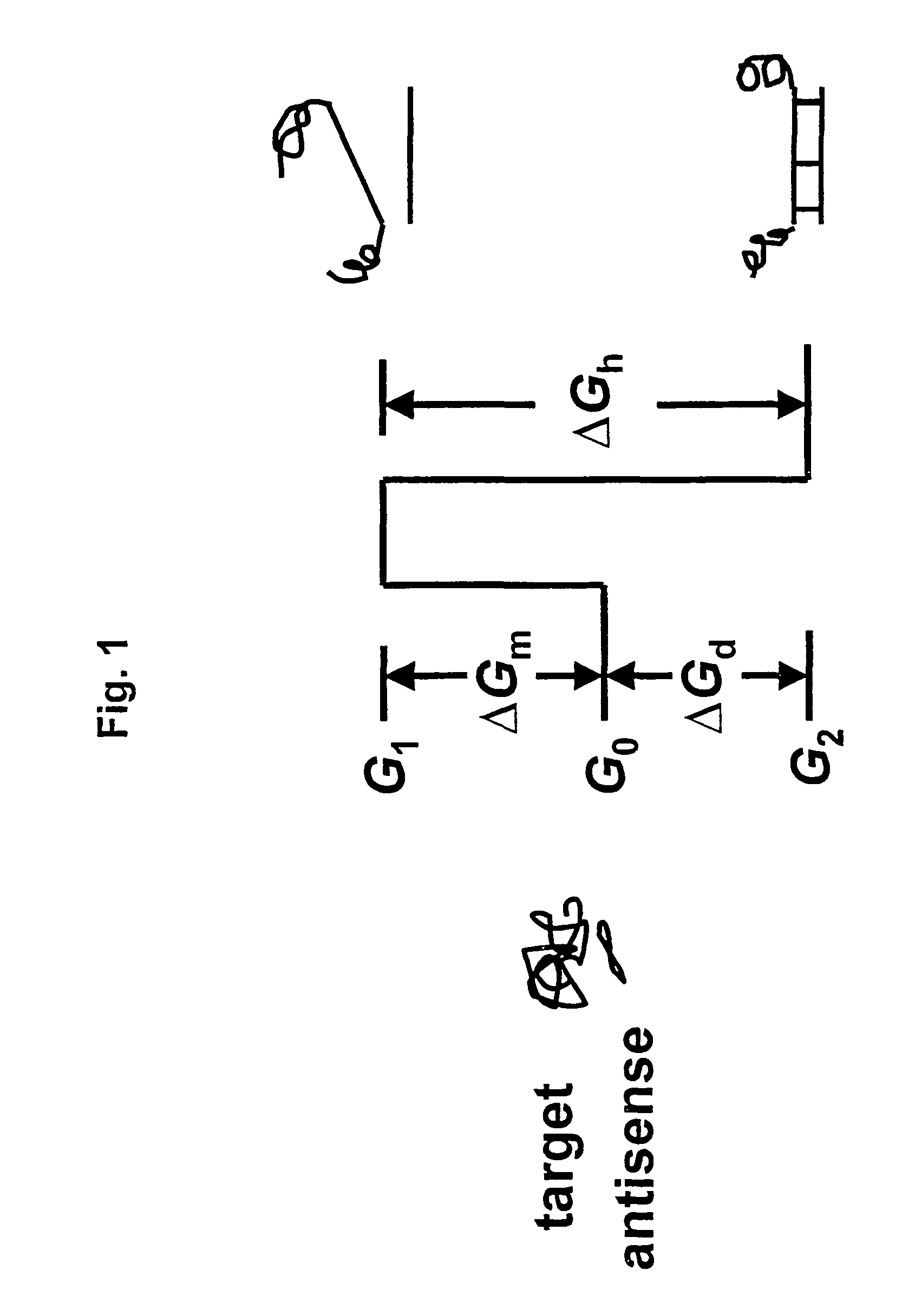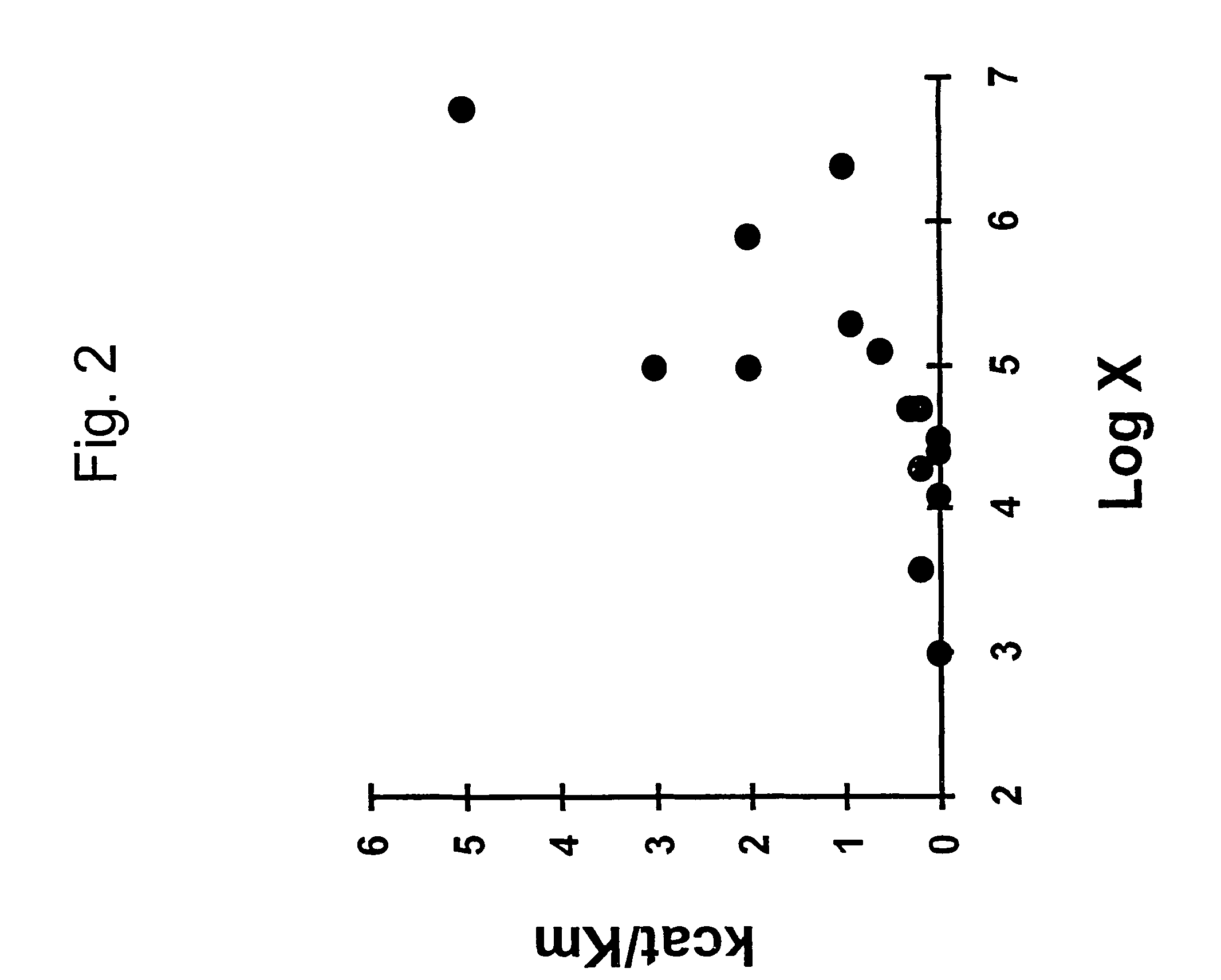Selection of target sites for antisense attack of RNA
a target site and antisense technology, applied in the field of antisense attack target sites, can solve the problems of difficult identification of favorable sites in a target rna for antisense binding, interference with rna splicing, transcription, translation, replication, etc., and achieve the effect of free energy and relatively straightforward calculation of the rate factor for hybridization to any target si
- Summary
- Abstract
- Description
- Claims
- Application Information
AI Technical Summary
Benefits of technology
Problems solved by technology
Method used
Image
Examples
example 1
Correlation of Initial Rate Constant for Oligodeoxynucleotide-RNA Hybridization
[0097]We first tested the ability of Equation 14 to predict initial hybridization rate using a 101-nucleotide RNA target for which initial hybridization rates of 5 antisense DNA oligonucleotides have been measured (Schwille et al., 1996). FIG. 3A (left) shows the secondary structures of the RNA target and antisense DNA as predicted by GCG FOLDRNA program.
[0098]The antisense DNAs with lengths ranging from 19 to 37 nucleotides are targeted at different sites. We assume that hybridization begins with nucleation in a sub-region of base pairing that has the maximum hybridization rate constant among all sub-regions of the molecule.
[0099]We calculated the values of
[0100]x=1(CⅇΔGm / RT+ⅇΔGd / RT)+[S]
for all the sub-regions having 15 nt for each antisense oligonucleotide where [S0] is the initial concentration of target RNA. The maximum, taken as k / k2, was compared with measured initial binding constant in Ta...
example 2
Identification of Nucleation Sites for RNA-RNA
[0105]RNA-RNA annealing is proposed to initiate through contacts over a short region (kissing) that lead to formation of a stable complex. The stable nucleation complex is then elongated to form full-length hybrid. Nucleation is expected to be rate limiting for long RNA-RNA hybridization; therefore considerable effort has been made to understand the elements required for nucleation. The loop-loop contact model asserts that rapid hybridization begins with contact between loops present in both antisense and target RNA. Although the model explains some examples, others exist in which the initial contact regions are not in loops. It has been difficult to predict nucleation regions from sequence information because loop regions must be determined by single-strand mapping and because multiple loops may be present. Equation 14 can be used to identify nucleation sites as regions having maximum hybridization rate factor when calculated stepwise f...
example 3
Identification of Accessible Sites for Antisense ODN Hybridization to HIV-1 Integrase mRNA
[0108]As a test for the ability of the rate factor (x in equation 14) to be used as a predictor of target site hybridization, we examined 32 sites within HIV-1 integrase mRNA that had values of x ranging from 10−2 to 108. We prepared antisense oligodeoxynucleotides (ODNs) complementary to each site and incubated each oligonucleotide with radioactively labeled integrase mRNA and RNase H in the presence of 0.45 mM MgCl2. All reactants were added at the same time, and the incubation time was limited; thus the quasi-steady-state approximation applied. Radioactive mRNA, transcribed in vitro, was incubated with individual oligonucleotides and RNase H in 0.45 mM MgCl2 for 13 min. The target RNA (935 nt) and the cleavage products were separated by gel electrophoresis and detected with a PhophoImager (bottom portion of figure). The rate factor calculated for each site is shown at the top of the correspo...
PUM
| Property | Measurement | Unit |
|---|---|---|
| diameter | aaaaa | aaaaa |
| area | aaaaa | aaaaa |
| area | aaaaa | aaaaa |
Abstract
Description
Claims
Application Information
 Login to View More
Login to View More - R&D
- Intellectual Property
- Life Sciences
- Materials
- Tech Scout
- Unparalleled Data Quality
- Higher Quality Content
- 60% Fewer Hallucinations
Browse by: Latest US Patents, China's latest patents, Technical Efficacy Thesaurus, Application Domain, Technology Topic, Popular Technical Reports.
© 2025 PatSnap. All rights reserved.Legal|Privacy policy|Modern Slavery Act Transparency Statement|Sitemap|About US| Contact US: help@patsnap.com



